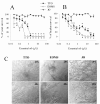Beneficial effect of Mentha suaveolens essential oil in the treatment of vaginal candidiasis assessed by real-time monitoring of infection
- PMID: 21356078
- PMCID: PMC3056850
- DOI: 10.1186/1472-6882-11-18
Beneficial effect of Mentha suaveolens essential oil in the treatment of vaginal candidiasis assessed by real-time monitoring of infection
Abstract
Background: Vaginal candidiasis is a frequent and common distressing disease affecting up to 75% of the women of fertile age; most of these women have recurrent episodes. Essential oils from aromatic plants have been shown to have antimicrobial and antifungal activities. This study was aimed at assessing the anti-fungal activity of essential oil from Mentha suaveolens (EOMS) in an experimental infection of vaginal candidiasis.
Methods: The in vitro and in vivo activity of EOMS was assessed. The in vitro activity was evaluated under standard CLSI methods, and the in vivo analysis was carried out by exploiting a novel, non-invasive model of vaginal candidiasis in mice based on an in vivo imaging technique. Differences between essential oil treated and saline treated mice were evaluated by the non-parametric Mann-Whitney U-test. Viable count data from a time kill assay and yeast and hyphae survival test were compared using the Student's t-test (two-tailed).
Results: Our main findings were: i) EOMS shows potent candidastatic and candidacidal activity in an in vitro experimental system; ii) EOMS gives a degree of protection against vaginal candidiasis in an in vivo experimental system.
Conclusions: This study shows for the first time that the essential oil of a Moroccan plant Mentha suaveolens is candidastatic and candidacidal in vitro, and has a degree of anticandidal activity in a model of vaginal infection, as demonstrated in an in vivo monitoring imaging system. We conclude that our findings lay the ground for further, more extensive investigations to identify the active EOMS component(s), promising in the therapeutically problematic setting of chronic vaginal candidiasis in humans.
Figures





Similar articles
-
Novel Preclinical Study of Galloylquinic Acid Compounds from Copaifera lucens with Potent Antifungal Activity against Vaginal Candidiasis Induced in a Murine Model via Multitarget Modes of Action.Microbiol Spectr. 2022 Oct 26;10(5):e0272421. doi: 10.1128/spectrum.02724-21. Epub 2022 Aug 16. Microbiol Spectr. 2022. PMID: 35972130 Free PMC article.
-
Proanthocyanidin polymeric tannins from Stryphnodendron adstringens are effective against Candida spp. isolates and for vaginal candidiasis treatment.J Ethnopharmacol. 2018 Apr 24;216:184-190. doi: 10.1016/j.jep.2018.01.008. Epub 2018 Jan 8. J Ethnopharmacol. 2018. PMID: 29325916
-
Essential oil of Melaleuca alternifolia for the treatment of oral candidiasis induced in an immunosuppressed mouse model.BMC Complement Altern Med. 2014 Dec 15;14:489. doi: 10.1186/1472-6882-14-489. BMC Complement Altern Med. 2014. PMID: 25510285 Free PMC article.
-
Essential oil and nanocarrier-based formulations approaches for vaginal candidiasis.Ther Deliv. 2023 Mar;14(3):207-225. doi: 10.4155/tde-2022-0058. Epub 2023 May 16. Ther Deliv. 2023. PMID: 37191049 Review.
-
Natural Products for Vulvovaginal Candidiasis Treatment: Evidence from Clinical Trials.Curr Top Med Chem. 2018;18(15):1324-1332. doi: 10.2174/1568026618666181002111341. Curr Top Med Chem. 2018. PMID: 30277156 Review.
Cited by
-
Anti-Candida Activity of Essential Oils from Lamiaceae Plants from the Mediterranean Area and the Middle East.Antibiotics (Basel). 2020 Jul 9;9(7):395. doi: 10.3390/antibiotics9070395. Antibiotics (Basel). 2020. PMID: 32660009 Free PMC article. Review.
-
Chemical Composition and Anti-Candida Activity of Mentha suaveolens Ehrh. Essential Oils Obtained by Different Distillation Processes.Molecules. 2023 Oct 4;28(19):6934. doi: 10.3390/molecules28196934. Molecules. 2023. PMID: 37836777 Free PMC article.
-
Quantification methods of Candida albicans are independent irrespective of fungal morphology.Microb Cell. 2024 Jul 26;11:265-277. doi: 10.15698/mic2024.07.831. eCollection 2024. Microb Cell. 2024. PMID: 39081907 Free PMC article.
-
Synergistic effects of carvacrol, α-terpinene, γ-terpinene, ρ-cymene and linalool against Gardnerella species.Sci Rep. 2022 Mar 15;12(1):4417. doi: 10.1038/s41598-022-08217-w. Sci Rep. 2022. PMID: 35292704 Free PMC article.
-
Essential Oils of Lamiaceae Family Plants as Antifungals.Biomolecules. 2020 Jan 7;10(1):103. doi: 10.3390/biom10010103. Biomolecules. 2020. PMID: 31936168 Free PMC article. Review.
References
-
- Calderone RA, (ed) Candida and Candidiasis. Washington, D.C.: ASM Press; 2002.
-
- Odds FC, (ed) Candida and Candidosis. 2. London, United Kingdom: Bailliere Tindall; 1988.
Publication types
MeSH terms
Substances
LinkOut - more resources
Full Text Sources
Medical

